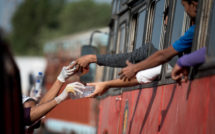

This is part of our special feature, Networks of Solidarity During Crises.
Outsourcing care and tradition
Throughout much of the twentieth and early twenty-first centuries, most societies witnessed a steady growth in life expectancy. In much of the Global North, but also in wealthier parts of the Global South, this generated and continues to generate a growing demand for affordable elderly care workers—a demand that many societies meet through low-wage migrant labor from the Global South.
Campania, like much of Southern Italy, is a relatively recent destination for labor migrants, but has a much longer history as an initial transit destination for asylum seekers and undocumented migrants given its geopolitical situation, low cost of living, and expansive informal sector. Nationwide, women make 51.7 percent of the known foreign-born population, with Europe as the main sending region, though communities from the African continent, Latin America, and Asia are also present (Centro Idos, 2019). Participants in this study reflect this diversity, as well as a growing trend for live-in care workers to be in their mid-forties or older (Solari, 2017). All had migrated to help support family members, including spouses, siblings, children, and grandchildren.Nancy Fraser (2011) observed that a key feature of neoliberal capitalism is that it is constantly redefining different types of labor to families, and more significantly, to women—while undermining the resources needed to carry out such work. Examples include the privatization of healthcare and education, the depletion of paid leaves of absence and the stigmatization of domestic work as “unskilled.”
While life expectancy has grown, public subsidies for personal assistance remain limited, as are opportunities for paid family leave. This, coupled with patriarchal views defining reproductive work as unskilled generates a high demand for precarious workers, to whom such labor can be outsourced for substandard wages. On this matter, Miraftab (2016) highlighted that it is almost exclusively displaced workers that take on reproductive and low-age manual labor, driven by the need to support their families, but also with the tacit understanding that should they become ill or injured, they would be able to return home to receive care.
While all European countries provide some form of state subsidies for the care of aging persons and the chronically ill, the spatial allocation of this work yields a significant distinction, as some countries place semi-independent seniors into specialized facilities such as nursing homes and retirement communities, while others subsidize care within the household (Van Hooren et al, 2012). Although both types of care arrangements coexist in most societies, Italy and Mediterranean countries in general prefer a home-care model.
Both regimes have strengths and weaknesses, with facilities providing accessible spaces, on-site assistance, and social interactions among guests, while the home care model allows individuals to remain connected to their families and neighborhoods. During COVID-19, retirement communities risk becoming infection hotbeds, but seniors living at home may become infected through asymptomatic or pre-symptomatic relatives.
I begin this reflection with an overview of migrant care workers’ experiences in Campania prior to COVID-19, which I use to highlight pre-existing structural conditions placing this diverse group of workers at risk of different forms of exploitation and health problems. Following, I draw on preliminary data concerning how migrant domestic workers in Naples are faring amidst the pandemic, as of Spring and Summer 2020.
Care workers’ lives in Campania, Italy: Pre-pandemic considerations
Most female migrants work in cities, in the service industry and as care workers. Although home cleaning is the most common employment category formally reported, I have previously published that such statistics may be misleading, as in many cases those who employ migrant caregivers report such workers as “part-time home cleaners” to local social security offices, which are tasked with ensuring that employees receive the appropriate compensation and benefits each month (Bonatti 2018). This subterfuge allows employers to retain a stable worker while minimizing their expenses, as by Italian labor laws, care-workers are entitled to more generous wages and benefits than home cleaners, a difference that is even greater when the work is full-time or live-in. Since many migrants’ eligibility to hold a visa is contingent upon a formal labor contract, few can object to this wage theft. However, some negotiate for employers to pay some of the missing benefits in cash.
The actual chores that migrant domestic workers perform include keeping the house of employers and their family members in addition to providing care for one or more seniors—a move that allows Italian families to abide by and reproduce the extended family and communal values of home-care for the elderly and the ill, without having to give up on the professional and social life expectations of the twenty-first century.
Michaela, the C.E.O of an employment agency specializing in care labor, explained what happens once families have found a suitable caregiver:
Adult children really just want to be left alone and not worry too much. If the mother (or the father, though it happens less) are happy, and well-taken care of, they go visit but don’t get into the caregiver’s way. They are happy to have them do the work, and just visit.(…) The only reason I ever see children getting very much involved is if the family has a little wealth (…) if they suspect or are afraid that the caregiver might be stealing small sums every now and then (July 8 2014).
For many Italians, the presence of care workers generates a sanitized or romanticized perception of aging and death, as family members are less involved with daily hygiene and difficulties facing ageing persons. However, these misperceptions are only possible because migrant care workers are there to manage the daily realities of ageing, illness and death—an emotional and material burden that many must face in addition to the pain of being displaced from one’s home.
In 2014, Alina, a Romanian woman in her forties, described this like so:
After so many years of taking care of sick and dying people, I started to fall ill myself. One cannot do that kind of work all the time. I went to the doctor many times, but they found nothing wrong with my body. (July 9, 2014)
The toll that exploitative labor regimes place on migrant care workers’ well-being cannot be overstated. First, emotional transfers that can lead migrants to become fond of those they care for as a way of coping with the separation from their families (Hochschilds, 2002). Second, in the case of elderly care workers in Naples I found that most of them remain with one main employer until the latter’s passing or hospitalization. This makes the transition between jobs particularly difficult for live-in workers, who must move out of a household, find a new employer, negotiate for visas and wages, move in and quickly learn how to get along and care for this new person—while they are mourning their previous employer, to whom most workers reported becoming at least somewhat close with.
For most labor migrants, being away from one’s home and loved ones, and the precariousness they experience in host societies as exploited workforces are possibly the two most important challenges. However, for care-workers, the burden of dealing with illness and death as part of one’s job represents an oftentimes overlooked burden. These concerns have existed long before the outbreak of COVID-19, though the pandemic has exacerbated them considerably.
Sometimes the fear of something happening to family members at home becomes a constant source of worry. Ana, a Georgian woman in her sixties, admitted:
I love talking to my family but we’ve had so many bad things happen to us that every time I see an unexpected call from them, I do the Sign of the Cross and pray it’s nothing bad (July 10, 2014).
Under pre-pandemic conditions, migrant women found several personal and collective ways to face problems ranging from emotional well-being to employment opportunities. Some of these are personal, such as spirituality and religious devotions. During the 2014 and 2015 interviews, I noted that it was very common for Christian informants to wear an inexpensive cross around their neck, and to cling to it whenever they spoke about their children and loved ones back home.
In addition to spirituality, getting together regularly with co-nationals in Italy was also an important avenue to relax and share information about potential employers, but also to strategize on how to support workers facing an emergency. These encounters generally take place in shared apartments that medium and large groups of migrants rent as a home base for the community, to get together during days off and to host those in need. Ana described this as follows:
We have three rooms, and the kitchen. The rent is about 600 euros, we all divide- 15 people. We are all from Georgia, all women. One room we keep our suitcases, one we cook and eat, and one we use for sleep- only two people right now, they are without work and need a new job. I cook often, I like that, on Sundays. First we do the groceries, then we talk and then we eat. Thursday, not so much, we don’t have time- we just have coffee (July 10, 2014).
Enjoying a local Georgian home-cooked meal in Naples while spending time with fellow migrants meant a long overdue break from intense days and nights spent working and following the routines of a foreign household. In Naples, many migrants’ apartments are located close to the main train station, which is easy to reach but far from to the wealthier neighborhoods where most women work. These forms of segregation forces migrant caregivers to spend most of their time isolated from fellow migrants.
Whenever the health conditions of employers allow, most migrant domestic workers have about one hour (some even have two) of rest or down time early in the afternoon, after lunch. However, this ‘break’ takes place in the employers’ homes, i.e., on the job, hence the extent to which it is available is unpredictable. As Amira, a Tunisian informant shared, “If the lady needs water or the bathroom when I am on break, what am I going to do, leave her waiting?” (July 10, 2014)
While helpful in some ways, breaks spent on the workplace cannot address problems such as lack of privacy and claustrophobia, which is particularly common for those before migrating, had a more active lifestyle. Prior to the coronavirus outbreak, some migrant domestic workers were eager to perform any task taking them outdoors. As indicated previously, it is quite common for employers’ adult children to prefer to manage household expenses, including shopping, themselves, for fear that those they trust with providing life-saving medications to their parents might steal some change. This left taking out garbage and recyclables, an unglamorous chore involving the management of waste and dirt, but also one that could easily be used to “stretch my legs, say a quick hello to a friend or make a private phone call.” (Ana, July 10, 2014).
Care work in the time of COVID-19
Based on the depiction of live-in elderly care labor provided above, it is easy to see how the COVID-19 outbreak in general, and particularly the strict lockdowns taking place in various parts of Italy, can take a heavy toll on domestic workers, who find themselves especially anxious for their families back home, not knowing when they will get to see them next, and increasingly cut off from their communities. Preliminary findings indicate that the pandemic is exacerbating several of the pre-existing challenges facing migrant domestic workers, including isolation, negotiating the length of their time abroad, and institutional exploitation of labor regimes.
As of May 30, 2020, one informant reported she had not seen any of her friends in weeks, for reasons ranging from the prohibition of social gatherings, unreliable (and from a health perspective, hazardous) public transport, as well as employing families seeking to minimize the risk of contagion by having domestic workers remain in the home as much as possible. Live-in domestic workers find themselves on the clock full-time, indefinitely, disconnected from networks of companionship and solidarity that until then had offered emotional and material support.
Preliminary conversations also indicate that chores involving time out of doors—grocery shopping, going to the pharmacy, taking out the garbage or walking dogs—are generally, but not always performed by employers. In part, this can be explained with employing families prioritizing their own cabin fever over the ones of their employees. However, for several months, anyone leaving the home was required to provide the authorities with a self-declaration form declaring that they were leaving the house to fulfill essential duties and showing proof of residence or employment in that district. Understandably, these requirements place additional barriers for undocumented migrants and ones on expired visas, despite the Italian state conceding six months moratorium on immigration proceedings, as part of its effort to contain the pandemic. And while the self-declaration form itself can seem straightforward, completing it and interacting with authorities is also more difficult for those who are fearful or not fluent in Italian.
Additional problems facing migrant domestic workers derive from travel restrictions. Trummer (2020) has recently drawn attention to the challenges facing migrant domestic workers stranded in their home countries without income. Something I’ve discovered in my recent conversations is the timing of return migration, as travel restrictions, and more importantly, the economic collapse generated by COVID-19 is forcing even those with upcoming return migration plans to delay retirement and work in Italy for a while longer, as deteriorating economic conditions at home renders migrant women’s remittances even more precious. On June 29, 2020, one informant shared her distress at having to re-apply for a work permit to remain in Italy indefinitely, after having made arrangements to finally retire at home—arrangements that included booking her ticket and even collecting her benefits from the social security office.
Delaying return plans indefinitely is heartbreaking for anyone. Many live-in domestic workers were already seniors upon migrating to Italy, and now must continue to hold a physically demanding, full-time job well into their sixties and seventies -an age group that is overall less healthy, and more vulnerable to novel coronavirus. The pandemic is thus exacerbating global inequalities pertaining to retirement opportunities for women in the Global South, as well as creating new ones where seniors of the Global North can shelter in the comfort of their homes, because elderly women in the Global South have no choice but taking care of them.
Conclusion
At the time of writing, Italian immigration politics in the context of COVID-19 are still being debated, with advocates generally associated with the leftist Democratic party and with the Catholic Church advocating for more expansive immigration policies, highlighting how the labor that many perform in agriculture and in domestic service is indeed essential, particularly amid a pandemic. Although these words, like the “grace periods” offered to those who had fallen out of status, can represent a welcome change compared to the positions of the League and other fascist-inspired groups, in April 2020, all migrants (including ones with long-standing work permits) were denied a stimulus check. Some categories of immigrants, but not live-in workers, are eligible for a more recent subsidy (INPS, 2020). It remains to be seen whether these delayed funds were enough to support those who work full-time and especially those who are raising children in Italy. Recognizing labor migrants’ work as essential may help dispel xenophobic narratives of European countries’ immigration policies as “charitable acts” that wealthier societies perform to their own detriment. Historically, European countries’ immigration regimes reproduce an exploitative labor structure for displaced workers. In 2020, under the pandemic circumstances, travel restrictions, the risk of contagion, spiking social inequalities, and economic crises, workers have even fewer opportunities to seek out different employers, or to return home to receive or provide care with family and loved ones. While pandemic politics, and the outbreak itself is still unraveling, it is becoming clear is that by providing essential care labor to host societies on to support their families in the home country, migrant care workers are giving people across the globe a better chance to survive the pandemic—at the cost of their physical and mental health.
Valeria Bonatti holds a PhD in Sociology and works as a Lecturer of Global Studies at the University of Illinois Urbana-Champaign, where she teaches courses in Global Health, Research Methods and Development. Her research focuses on displaced workers’ contributions to sustainable practices in host societies, as well as on immigrant and refugee health. Some of her recent work appeared in Migration Studies and in International Labor and Working-Class History
References:
Bonatti, Valeria. “Taking out the garbage: Migrant women’s unseen environmental work.” European Journal of Women’s Studies 25, no. 1 (2018): 41-55.
Hochschild, Arlie R., and Barbara Ehrenreich. “Love and gold.” (2002): 15-30.
Idos, Centro Studi e Ricerche. Dossier Statistico Immigrazione IDOS Press 2019
Istituto Nazionale per la Previdenza Sociale. “La domanda per l’indennità Covid-19 per lavoratori domestici è online,” June 1 2020 https://www.inps.it/nuovoportaleinps/default.aspx?itemdir=53725. Last accessed July 11.
Fraser, Nancy. “Capitalism’s Crisis of Care.” Dissent 63, no. 4 (2016): 30-37.
Miraftab, Faranak. Global heartland: Displaced labor, transnational lives, and local placemaking. Indiana University Press, 2016.
Solari, Cinzia D. On the Shoulders of Grandmothers: Gender, Migration, and Post-Soviet Nation-state Building. Routledge, 2017.
Trummer, Ursula.“European Borders, COVID-19, and the Economy of Home Care” 21st Century Global Dynamics In global-e vol 13 no. 57. 2020
Van Hooren, Franca, and Uwe Becker. “One welfare state, two care regimes: Understanding developments in child and elderly care policies in the Netherlands.” Social Policy & Administration 46, no. 1 (2012): 83-107.
Published on October 13, 2020.




